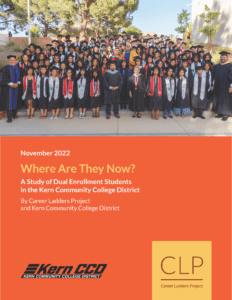 Dual enrollment1 across the Kern Community College District (KCCD) has grown dramatically in the past nine years. In 2013–14, there were fewer than 1,000 dual enrollment students at the district’s three colleges—Bakersfield College, Cerro Coso Community College, and Porterville College. By the 2021–22 academic year, there were more than 12,000 dual enrollment students. The rise coincided with a large population increase in the county, the district’s move to implement reforms that streamline and recenter student needs using a guided pathways framework, and a concentrated effort by Bakersfield College to increase access to college through dual enrollment in the service areas with the lowest overall postsecondary attainment rates. In addition to the substantial growth in access, high school students are succeeding in their college courses; dual enrollment retention and success rates at all three colleges are upwards of 90% and 80%, respectively.
Dual enrollment1 across the Kern Community College District (KCCD) has grown dramatically in the past nine years. In 2013–14, there were fewer than 1,000 dual enrollment students at the district’s three colleges—Bakersfield College, Cerro Coso Community College, and Porterville College. By the 2021–22 academic year, there were more than 12,000 dual enrollment students. The rise coincided with a large population increase in the county, the district’s move to implement reforms that streamline and recenter student needs using a guided pathways framework, and a concentrated effort by Bakersfield College to increase access to college through dual enrollment in the service areas with the lowest overall postsecondary attainment rates. In addition to the substantial growth in access, high school students are succeeding in their college courses; dual enrollment retention and success rates at all three colleges are upwards of 90% and 80%, respectively.
Long acknowledged as an effective acceleration strategy, dual enrollment has emerged as a powerful equity strategy when designed for the success of students who might not otherwise attend college. By designing dual enrollment for equity—from recruitment to the classroom experience—the community college practitioners at KCCD and its colleges hope to close college-going equity gaps and, ultimately, gaps in college attainment. Having successfully increased the number of students participating in dual enrollment, they wanted to understand how dual enrollment affects post-high school outcomes. The literature suggests that students are likely to continue on to postsecondary education and that students from underrepresented populations will see higher gains. To find out, staff from the Bakersfield College and KCCD Early College teams, the Bakersfield College Office of Institutional Effectiveness, and the Career Ladders Project (CLP) teamed up to discover where these former dual enrollment students are now. The KCCD research team and CLP conducted a mixed methods study using quantitative data from administrative data systems and qualitative data collected from focus groups to gain insight into the subsequent trajectories of dual enrollment students.
Prepared by Career Ladders Project
November 2022